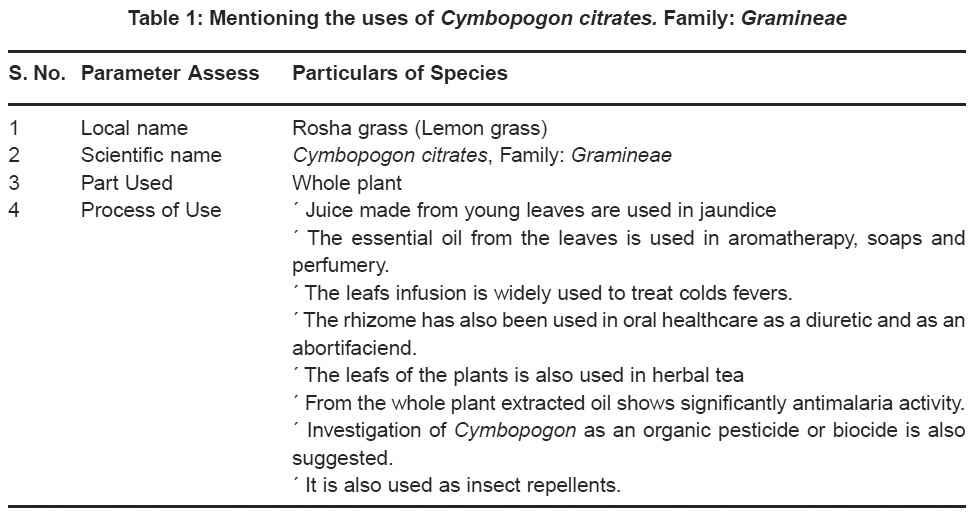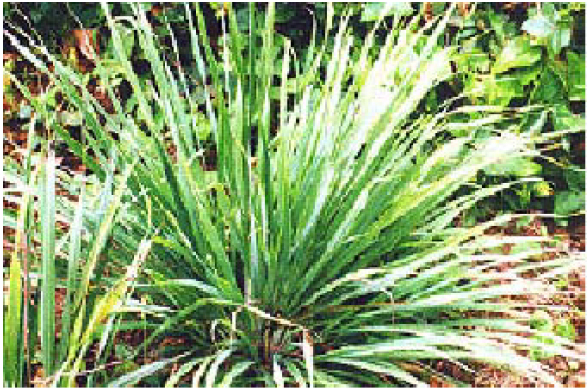Assessment of medicinal plant Cymbopogon citratus in north Maharashtra Univresity campus of Khandesh region
A.C. Sonawane2 , R.T. Chaudhari1 * , Y.D. Bafna2 , M.N. Kulkarni2 and B. Ram Mridula2
1
Department of zoology,
S.M.T.G.G. Khadase College,
Muktai Nagar,
Jalgaon,
India
2
School of Environmental and Earth Sciences,
North Maharashtra University,
Jalgaon,
India
DOI: http://dx.doi.org/10.12944/CWE.3.2.10
In the present investigation the current status of medicinal plants used by traditional vaidyas is studied in Khandesh area of Maharashtra state, India. Information was gathered using semi-structured questionnaires about various traditional vaidyas. They were questioned about the types of ailments treated with plants and the preparation of herbal medical formulation. The study of Cymbopogon citrates is probably of Indian origin. However, it is now naturalized and found along path sides in the North Maharashtra University campus of Jalgaon district, Maharashtra and commonly cultivated in humid tropical and subtropical regions of the world. It is difficult to distinguish Cymbopogon nardus (L) rendle (Synonyms Andropogon nardus L.). Cymbopogon nardus is called citronella grass and it possesses a different odour of its essential oil compared with Cymbopogon citratus.
Copy the following to cite this article:
Sonawane A.C, Chaudhari R.T, Bafna Y.D, Kulkarni M.N, Mridula B.R, Thorat S.R. Assessment of medicinal plant Cymbopogon citratus in north Maharashtra Univresity campus of Khandesh region. Curr World Environ 2008;3(2):269-272 DOI:http://dx.doi.org/10.12944/CWE.3.2.10
Copy the following to cite this URL:
Sonawane A.C, Chaudhari R.T, Bafna Y.D, Kulkarni M.N, Mridula B.R, Thorat S.R. Assessment of medicinal plant Cymbopogon citratus in north Maharashtra Univresity campus of Khandesh region. Curr World Environ 2008;3(2):269-272. Available from: http://www.cwejournal.org?p=132/
Download article (pdf) Citation Manager Publish History
Select type of program for download
| Endnote EndNote format (Mac & Win) | |
| Reference Manager Ris format (Win only) | |
| Procite Ris format (Win only) | |
| Medlars Format | |
| RefWorks Format RefWorks format (Mac & Win) | |
| BibTex Format BibTex format (Mac & Win) |
Article Publishing History
| Received: | 2008-08-07 |
|---|---|
| Accepted: | 2008-09-09 |
Introduction
India is one of the leading countries in Asia in terms of the wealth of traditional knowledge system related to the use of plant species. India is also known to harbour a rich diversity of higher plant species about 17,000 species of which 7500 are known as medicinal plants. (Shiva, 1996). such a huge number of medicinal plant species has allowed the evolution of many systems of herbal medicines. Ayurveda is arguably the oldest medical system in Indian subcontinent.
Cymbopogon citratus locally called Lemon grass or Rosha grass is observed largely in North Maharashtra University campus area of Jalgaon city. Since the plant rarely flower or set seed, propagation is by root or plant division off shoots from healthy plants are cut back to 12 cm trimmed of dead or extensive roots and treated with fungicides.
Active Principle
From the leaves its oil is reach in citral and other terpenes, such as myrcene. Due to its easy polymerization, myrcene is responsible for the early deterioration of the oil. Pure citral is isolated from the oil and used as a key raw material in the manufacture of vitamin A.
Further research is recommended into this grass not only in organic farming but also for the development of value added products such as “Aqua-resins”, but also as a grass barriers and as a source of natural pesticides a comprehensive monograph on Cymbopogon is available in Indian subcontinent (Kumar et. al. 2000).
Material and Methods
The perennial, robust, lemon scented grass forms dense Clumps; the leaf blades ca. 1 m long and 5-15 mm broad tapering at both ends. The margin rough; inflorescences a panicle, rare produced in some places, 30-60 cm with sessile, linear, spikeletes. Cymbopogon citratus are probably observed in Indian subcontinent. Planting is done mainly on the flat 10-15 cm deep, with spacing 50-90 cm × 50-60 cm. A high plant density is maintained by filling in gaps as required for highest yields.
The essential oil from the leaves is used in aromatherapy, soaps and perfumery (Simon, 1984). Traditionally the leaf infusion has also been used in oral health care as a diuretis and as an abortifacient (Morton, 1981). The aerial parts are also sold in herbal teas, used commercially in baked foods and confectionary and also are used in sachets as an insect repellents. The essential oil shows significance antimalarial activity in the four-day suppressive in-vitro tests in Mice (Tchoumbougnang et. al. 2005).
Post-Harvest/Manufacturing Practices: Handling, Processing, Packaging and Storage
Wilting the herbage of lemon grass before distillation reduces moisture content, and has little effect on oil yields, but increases the citral content.
Drying in full sunlight for 3 days reduces oil yields but has little effect on oil quality.
 |
Table 1: Mentioning the uses of Cymbopogon citrates. Family: Gramineae Click here to view table |
Steam distillation is done on finely chopped fresh or partially dried lemon grass, leaves harvested preferably in the morning time (Oyen, LPA. et. al. 1999). The oil is brownish with a grassy citrus earthy undertone. It is specific gravity is about 0.9 and it is laevorotatory. The yields are 0.25-0.50% oil from the herbage (Oyen, LPA. et. al. 1999). The spent grass can be dried, composted and returned to the field or used as fodder.
Helminthosporium cymbopogi causes serious leaf spot disease but no serious pests of this grass are known. The first harvest is about 6 months after planting, and it can be done manually, in the morning time. The plants may then be harvested about four times each year. If harvested too often the productivity of the plant will be reduced and the plant might die. Mechanical harvesters are adjusted to cut at a height of 21 cm for best yields (Oyen, et. al., 1999). Harvested yields of 80 kg/ha/ year have been recorded.
Results and Discussion
The well analyzed and checklist information about plant and their material collected from the study area of North Maharashtra Univeristy campus is described in Table 1.
 |
Click here to view image |
Quality, Safety, Efficacy and Regulatory Framework
It is listed as a drug (Cymbopoginis citrati herba). Its derivative “West Indian Lemon grass oil is Cymbopoginis citrati aetheroleum” in the German Commission E Monographs (Blumenthal, M. et. al. 1998), however scientific data to validate its traditional therapeutic uses is inadequate. Cymbopogon citratus is generally recognized as safe for human consumption, whether as the plant extracts or its essential oil (Simon, JE., et. al. 1984). It is a highly rated folk medicine in India and Brazil, in the form of an infusion of 2 or 3 fresh or dried leaves in 150 mL hot water (Leite, JR., et. al. 1986). The essential oil has been approved for food use by the USFDA as "generally recognized as safe" GRAS No. 2624. It is registered in the Council of Europe under 38n. It possesses the International Standardization Organization standard as ISO 3217 since 1974. The Research Institute for Fragrance Materials (RIFM) has published a monograph on the physiological properties of lemon grass oil (Oyen, LPA. et. al. 1999). "In trade statistics hardly any distinction is made between the 2 major sources of lemongrass oils: West Indian lemongrass (Cymbopogon citratus) and East Indian lemongrass (Cymbopogon flexosus Nees ex. Steudel)"- J.F. Watson (Oyen, LPA. et. al. 1999). Good drainage is the most important soil requirement, usually of pH 5.5 - 7.5 (Simon, J E., et. al, 1984). Deep planting and earthing up are beneficial on sandy soils; but on heavy soils these practices are not advisable as the young plants are susceptible to root rot. When grown for its oil, the plant is rarely intercropped, because it needs ample water and full sunshine.
Careful weeding is extremely important, as weedy grasses may quickly invade a new plantation and once established are difficult to remove. The plant is often irrigated and has a modest nitrogen fertilizer requirement. Only the young expanding leaves actually synthesize and accumulate the essential oil (Oyen, et. al., 1999). Cymbopogon citratus can be a useful understory crop, since if it grows too tall the oil yield may be reduced.
Germplasm/ Collection/ Seed Sources
Several institutions in South and South-East Asia possess systematic collections of germplasm of Cymbopogon, such as in Kerala, India, the Research Institute for Spice and Medicinal Crops (RISMC), Bogor, Indonesia, and the National Board of Genetic Resources, New Delhi, India (Oyen, LPA. et. al., 1999). Some breeding programmes have developed new varieties of lemon grass (Blumenthal, M., et. al., 1998).
The main objective of this paper presentation was to generate and share information regarding species of medicinal and economic importance with conservation concern. To promote appropriate conservation measures for native medicinal plants in North Maharashtra University campus for sustainable production. To increase local people participation in native medicinal plant conservation. Encourage active participation by tribes and other holders of traditional ecological knowledge pertaining to native medicinal plants in Jalgaon, Dhule and Nandurbar Districts of Khandesh region.
References
-
Morton, JF. Atlas of Medicinal Plants of Middle America. C.C. Thomas Publishers, U.S.A (1981).
-
Adams, CD., Flowering Plants of Jamaica. University of the West Indies, Mona, Jamaica (1972).
-
Oyen, LPA. and Nguyen Xuan Dung (Editors). Plant Resources of South-East Asia. No.19. Essential Oil Plants. Backhuys Publishers, Leiden, The Netherlands (1999).
-
Tchoumbougnang, F. Amvan Zollo, PH., Dagne, E. and Mekonnen, Y., “In-vitro Antimalarial activity of essential oils from Cymbopogon citratus and Ocimum gratissimum on mice infected with Plesmodium berghei”. Planta Medica. (2005) 71: 20-23.
-
Blumenthal, M., Busse, WR., Goldberg, A., Gruenwald, J., Hall, T., Riggins, CW. and Rister, RS. (Editors). S. Klein and RS Rister (translators). The CompletevGerman Commission E Monographs - Therapeutic Guide to Herbal Medicines. American Botanical Council, Texas/ Integrative Medicine Communications, Boston, USA (1998).
-
Simon, JE., Chadwick, AF. And Craker, LE., Herbs. An Indexed Bibliography. 1971 - 1980. The scientific literature on selected herbs and aromatic and medicinal plants of the temperate zone. Archon Books, Hamden, CT, USA (1984).
-
Shiva, V., Protecting our Biological and Intellectual Heritage in the Age of Biopiracy. The research Foundation for Science, Technology and Natural Resources Policy, New Delhi, India (1996).
-
Leite, JR., Seabra, MV., Maluf, E., Assolant, K., Suchecki, D., Tufik, S., Klepacz, S., Callil, HM. and Carlini, EA., "Pharmacology of lemon grass (Cymbopogon citratus Stapf) III. Assessment of eventual toxic, hypnotic and anxiolytic effects on humans”. Journal of Ethnopharmacology, (1986) 17: 75 - 83.
-
Small scale production of essential oils. (Visit: for the Intermediate Technology Development Group, U.K.).
-
Susheela Raghavan., "Developing ethnic foods and ethnic flair with spices" Food Technology, (2004) 58(8).
-
Thomas, J., Lemon grass. In Advances in Horticulture Volume 11. Medicinal and Aromatic Plants. (Editors) KL. Chandra, R. Gupta. Malhotra Publishing House, New Delhi - 110064, India (1995).
-
Gruenwald, J., Brendler, T. and Jaenicke, C. (Scientific Editors). PDR for Herbal Medicines. 3rd Edition. Thompson PDR, Montvale, N.J., U.S.A.
-
Kumar, S., Dwivedi, S., Kukreja, AK., Sharma, JR. And Bagchi, GD. (Editors)., Cymbopogon: The Aromatic Grass Monograph. Central Institute of Medicinal and Aromatic Plants, Lucknow, India (2000).







